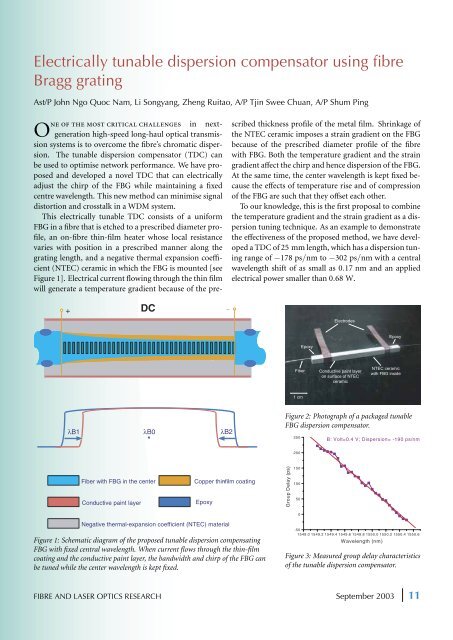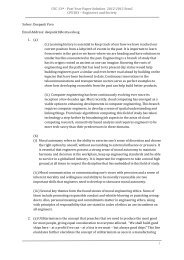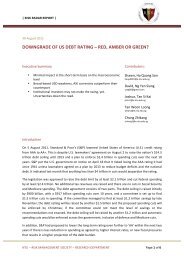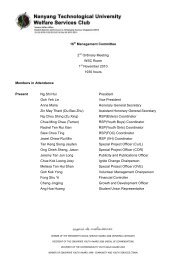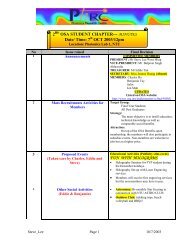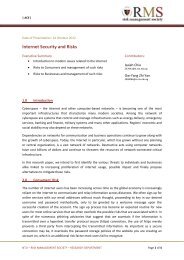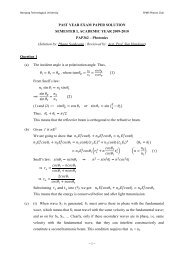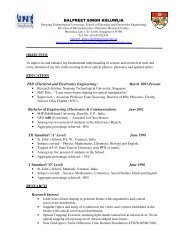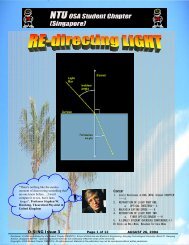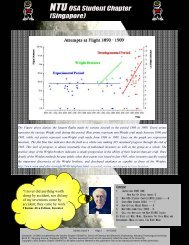PhRC NEWSLETTER PHOTONICS'La - Nanyang Technological ...
PhRC NEWSLETTER PHOTONICS'La - Nanyang Technological ...
PhRC NEWSLETTER PHOTONICS'La - Nanyang Technological ...
You also want an ePaper? Increase the reach of your titles
YUMPU automatically turns print PDFs into web optimized ePapers that Google loves.
Electrically tunable dispersion compensator using fibre<br />
Bragg grating<br />
Ast/P John Ngo Quoc Nam, Li Songyang, Zheng Ruitao, A/P Tjin Swee Chuan, A/P Shum Ping<br />
One of the most critical challenges in nextgeneration<br />
high-speed long-haul optical transmission<br />
systems is to overcome the fibre’s chromatic dispersion.<br />
The tunable dispersion compensator (TDC) can<br />
be used to optimise network performance. We have proposed<br />
and developed a novel TDC that can electrically<br />
adjust the chirp of the FBG while maintaining a fixed<br />
centre wavelength. This new method can minimise signal<br />
distortion and crosstalk in a WDM system.<br />
This electrically tunable TDC consists of a uniform<br />
FBG in a fibre that is etched to a prescribed diameter profile,<br />
an on-fibre thin-film heater whose local resistance<br />
varies with position in a prescribed manner along the<br />
grating length, and a negative thermal expansion coefficient<br />
(NTEC) ceramic in which the FBG is mounted [see<br />
Figure 1]. Electrical current flowing through the thin film<br />
will generate a temperature gradient because of the pre-<br />
+<br />
λB1<br />
Fiber with FBG in the center Copper thin-film coating<br />
Conductive paint layer<br />
DC<br />
λB0 λB2<br />
Epoxy<br />
Negative thermal-expansion coefficient (NTEC) material<br />
Figure 1: Schematic diagram of the proposed tunable dispersion compensating<br />
FBG with fixed central wavelength. When current flows through the thin-film<br />
coating and the conductive paint layer, the bandwidth and chirp of the FBG can<br />
be tuned while the center wavelength is kept fixed.<br />
_<br />
scribed thickness profile of the metal film. Shrinkage of<br />
the NTEC ceramic imposes a strain gradient on the FBG<br />
because of the prescribed diameter profile of the fibre<br />
with FBG. Both the temperature gradient and the strain<br />
gradient affect the chirp and hence dispersion of the FBG.<br />
At the same time, the center wavelength is kept fixed because<br />
the effects of temperature rise and of compression<br />
of the FBG are such that they offset each other.<br />
To our knowledge, this is the first proposal to combine<br />
the temperature gradient and the strain gradient as a dispersion<br />
tuning technique. As an example to demonstrate<br />
the effectiveness of the proposed method, we have developed<br />
a TDC of 25 mm length, which has a dispersion tuning<br />
range of −178 ps/nm to −302 ps/nm with a central<br />
wavelength shift of as small as 0.17 nm and an applied<br />
electrical power smaller than 0.68 W.<br />
Fiber<br />
1cm<br />
Epoxy<br />
Electrodes<br />
Conductive paint layer<br />
on surface of NTEC<br />
ceramic<br />
Epoxy<br />
NTEC ceramic<br />
with FBG inside<br />
Figure 2: Photograph of a packaged tunable<br />
FBG dispersion compensator.<br />
Group Delay (ps)<br />
250<br />
200<br />
150<br />
100<br />
50<br />
0<br />
B: Volt=0.4 V; Dispersion= -190 ps/nm<br />
-50<br />
1549.0 1549.2 1549.4 1549.6 1549.8 1550.0 1550.2 1550.4 1550.6<br />
Wavelength (nm)<br />
Figure 3: Measured group delay characteristics<br />
of the tunable dispersion compensator.<br />
FIBRE AND LASER OPTICS RESEARCH September 2003 11


